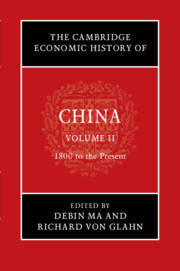Book contents
- The Cambridge Economic History of China
- The Cambridge Economic History of China
- The Cambridge Economic History of China
- Copyright page
- Contents
- Figures
- Maps
- Tables
- Contributors to Volume II
- Acknowledgments
- Note on Citations
- Introduction to Volume II
- Part I 1800–1950
- Part II 1950 to the Present
- 15 The Origin of China’s Communist Institutions
- 16 China’s Struggle with the Soviet Growth Model, 1949–1978
- 17 Living Standards in Maoist China
- 18 The Political Economy of China’s Great Leap Famine
- 19 China’s External Economic Relations during the Mao Era
- 20 The Chinese Economy in the Reform Era
- 21 China’s Great Boom as a Historical Process
- Index
- References
18 - The Political Economy of China’s Great Leap Famine
from Part II - 1950 to the Present
Published online by Cambridge University Press: 07 February 2022
- The Cambridge Economic History of China
- The Cambridge Economic History of China
- The Cambridge Economic History of China
- Copyright page
- Contents
- Figures
- Maps
- Tables
- Contributors to Volume II
- Acknowledgments
- Note on Citations
- Introduction to Volume II
- Part I 1800–1950
- Part II 1950 to the Present
- 15 The Origin of China’s Communist Institutions
- 16 China’s Struggle with the Soviet Growth Model, 1949–1978
- 17 Living Standards in Maoist China
- 18 The Political Economy of China’s Great Leap Famine
- 19 China’s External Economic Relations during the Mao Era
- 20 The Chinese Economy in the Reform Era
- 21 China’s Great Boom as a Historical Process
- Index
- References
Summary
Indisputably, the Great Leap Famine of 1958–61 stands out in Chinese history as the most profound demographic catastrophe after six centuries of nearly uninterrupted population growth. As some 30 million, or 5 percent of a population of 660 million, were wiped out within a short period of three years, it was by far the deadliest famine in human history. However, until the demographic consequences of this catastrophe were fully revealed in the 1980s, the outside world assumed that China had solved its food problem following the founding of the People’s Republic, when in fact the greatest famine in human history was just beginning to unfold.
Keywords
- Type
- Chapter
- Information
- The Cambridge Economic History of China , pp. 642 - 684Publisher: Cambridge University PressPrint publication year: 2022
References
Further Reading
- 1
- Cited by



